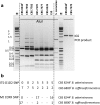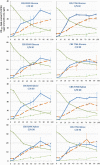Blastobotrys adeninivorans and B. raffinosifermentans, two sibling yeast species which accumulate lipids at elevated temperatures and from diverse sugars
- PMID: 31249618
- PMCID: PMC6587252
- DOI: 10.1186/s13068-019-1492-x
Blastobotrys adeninivorans and B. raffinosifermentans, two sibling yeast species which accumulate lipids at elevated temperatures and from diverse sugars
Abstract
Background: In the context of sustainable development, yeast are one class of microorganisms foreseen for the production of oil from diverse renewable feedstocks, in particular those that do not compete with the food supply. However, their use in bulk production, such as for the production of biodiesel, is still not cost effective, partly due to the possible poor use of desired substrates or poor robustness in the practical bioconversion process. We investigated the natural capacity of Blastobotrys adeninivorans, a yeast already used in biotechnology, to store lipids under different conditions.
Results: The genotyping of seven strains showed the species to actually be composed of two different groups, one that (including the well-known strain LS3) could be reassigned to Blastobotrys raffinosifermentans. We showed that, under nitrogen limitation, strains of both species can synthesize lipids to over 20% of their dry-cell weight during shake-flask cultivation in glucose or xylose medium for 96 h. In addition, organic acids were excreted into the medium. LS3, our best lipid-producing strain, could also accumulate lipids from exogenous oleic acid, up to 38.1 ± 1.6% of its dry-cell weight, and synthesize lipids from various sugar substrates, up to 36.6 ± 0.5% when growing in cellobiose. Both species, represented by LS3 and CBS 8244T, could grow with little filamentation in the lipogenic medium from 28 to 45 °C and reached lipid titers ranging from 1.76 ± 0.28 to 3.08 ± 0.49 g/L in flasks. Under these conditions, the maximum bioconversion yield (Y FA/S = 0.093 ± 0.017) was obtained with LS3 at 37 °C. The presence of genes for predicted subunits of an ATP citrate lyase in the genome of LS3 reinforces its oleaginous character.
Conclusions: Blastobotrys adeninivorans and B. raffinosifermentans, which are known to be xerotolerant and genetically-tractable, are promising biotechnological yeasts of the Saccharomycotina that could be further developed through genetic engineering for the production of microbial oil. To our knowledge, this is the first report of efficient lipid storage in yeast when cultivated at a temperature above 40 °C. This paves the way to help reducing costs through consolidated bioprocessing.
Keywords: Biotechnology; Lipid metabolism; Microbial oil; Oleaginous yeasts; Saccharomycotina; Thermotolerance.
Conflict of interest statement
Competing interestsThe authors declare that they have no competing interests.
Figures






Similar articles
-
Yeasts of the Blastobotrys genus are promising platform for lipid-based fuels and oleochemicals production.Appl Microbiol Biotechnol. 2021 Jun;105(12):4879-4897. doi: 10.1007/s00253-021-11354-3. Epub 2021 Jun 10. Appl Microbiol Biotechnol. 2021. PMID: 34110474 Review.
-
The native acyltransferase-coding genes DGA1 and DGA2 affect lipid accumulation in Blastobotrys raffinosifermentans differently when overexpressed.FEMS Yeast Res. 2020 Dec 17;20(8):foaa060. doi: 10.1093/femsyr/foaa060. FEMS Yeast Res. 2020. PMID: 33206977
-
The complete genome of Blastobotrys (Arxula) adeninivorans LS3 - a yeast of biotechnological interest.Biotechnol Biofuels. 2014 Apr 24;7:66. doi: 10.1186/1754-6834-7-66. eCollection 2014. Biotechnol Biofuels. 2014. PMID: 24834124 Free PMC article.
-
Screening of xylose utilizing and high lipid producing yeast strains as a potential candidate for industrial application.BMC Microbiol. 2022 Jul 7;22(1):173. doi: 10.1186/s12866-022-02586-y. BMC Microbiol. 2022. PMID: 35799117 Free PMC article.
-
Blastobotrys (Arxula) adeninivorans: a promising alternative yeast for biotechnology and basic research.Yeast. 2016 Oct;33(10):535-547. doi: 10.1002/yea.3180. Epub 2016 Aug 25. Yeast. 2016. PMID: 27372304 Review.
Cited by
-
Development of a Vector Set for High or Inducible Gene Expression and Protein Secretion in the Yeast Genus Blastobotrys.J Fungi (Basel). 2022 Apr 19;8(5):418. doi: 10.3390/jof8050418. J Fungi (Basel). 2022. PMID: 35628674 Free PMC article.
-
Yeasts of the Blastobotrys genus are promising platform for lipid-based fuels and oleochemicals production.Appl Microbiol Biotechnol. 2021 Jun;105(12):4879-4897. doi: 10.1007/s00253-021-11354-3. Epub 2021 Jun 10. Appl Microbiol Biotechnol. 2021. PMID: 34110474 Review.
-
Structural Insight into a Yeast Maltase-The BaAG2 from Blastobotrys adeninivorans with Transglycosylating Activity.J Fungi (Basel). 2021 Sep 29;7(10):816. doi: 10.3390/jof7100816. J Fungi (Basel). 2021. PMID: 34682239 Free PMC article.
-
Expanding the geographical distribution of Blastobotrysmalaysiensis (Saccharomycetales) beyond the Asian continent - a cave fungus first reported in the Americas.Biodivers Data J. 2022 Nov 15;10:e80226. doi: 10.3897/BDJ.10.e80226. eCollection 2022. Biodivers Data J. 2022. PMID: 36761671 Free PMC article.
-
Utilization of lignocellulosic biofuel conversion residue by diverse microorganisms.Biotechnol Biofuels Bioprod. 2022 Jun 24;15(1):70. doi: 10.1186/s13068-022-02168-0. Biotechnol Biofuels Bioprod. 2022. PMID: 35751080 Free PMC article.
References
-
- Middelhoven WJ, Hoogkamer-Te Niet MC, Kreger-Van Rij NJ. Trichosporon adeninovorans sp. nov., a yeast species utilizing adenine, xanthine, uric acid, putrescine and primary n-alkylamines as the sole source of carbon, nitrogen and energy. Antonie Van Leeuwenhoek. 1984;50:369–378. doi: 10.1007/BF00394651. - DOI - PubMed
LinkOut - more resources
Full Text Sources
Research Materials
Miscellaneous

